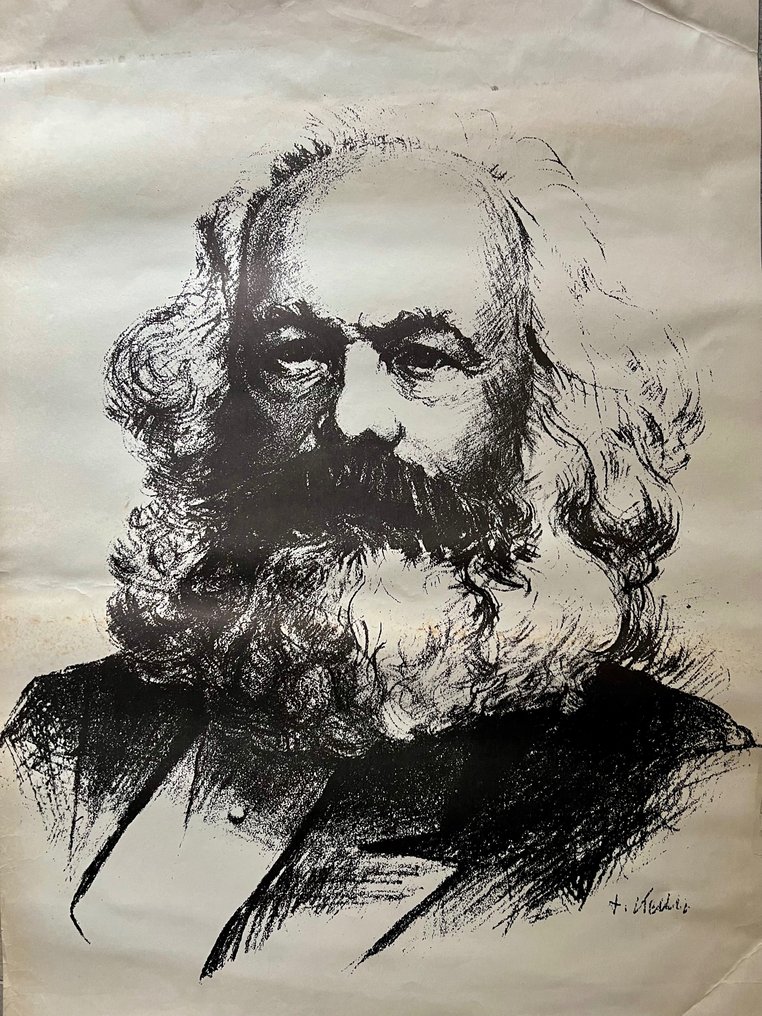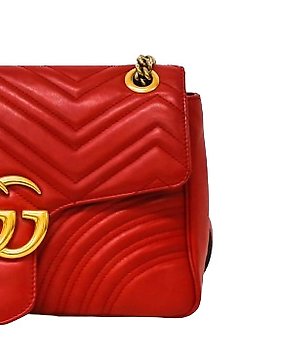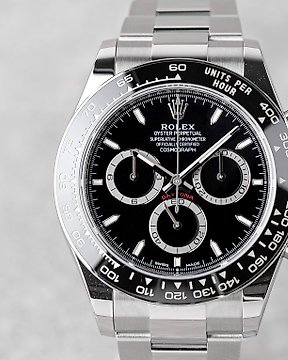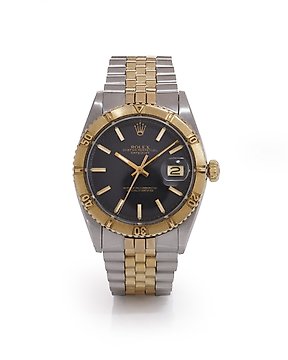Erg goede ervaring met deze verkoper. wederom blij met deze aankoop.
Zobacz tłumaczenieSandor Ék (Alex Keil) - 1969 Soviet Republic - pre war - Budapest - Hungary - Russian - USSR, socialist, communist - Lata 60.
Nr 84834683



Oroginal Vintage poster about Marx made by Sandor ék
lithography
Ék Sándor
1902 - 1975
Ék, Sándor (Alex Keil)
Sandor Ek or Alex Keil was a Hungarian graphic artist and poster designer, who worked in Hungary, Germany and Russia as well. His name was originally Leicht and he chose Ék and its German version, Keil (~wedge) as a movement name.
Growing up in a suburb of Pest (Angyalföld) as a poor working class child, he engaged in the socialist ideology from a very early age and by the time he was 16, he entered the Hungarian Communist Party (KMP). In 1919 the seventeen-year old boy happily greeted the Hungarian Soviet Republic, which existed 133 days. He drew political caricatures for papers and, after being a member of the Red Army for a short time, he studied arts in the school of Béla Uitz and József Nemes-Lampérth (important Hungarian painters of that age).
After the fall of the Hungarian Soviet Republic he immigrated to Vienna. In 1921 he participated in the “Young Worker’s International” in Moscow (where he met Lenin personally) and studied in VHUTEMASZ from El Liszickij for several months. During these times he was painting in modern and constructivist style, which he gave up soon for the obligatory socialist realism. He has also visited Berlin and Paris and later returned to Budapest, where he has been arrested. After 1925 he lived in Germany and worked for the “Rote Fahne”, “Arbeiter Illustrierte Zeitung” and for other leftist newspapers. Here he made a name for himself as a designer of leftist propaganda posters, similarly to John Heartfield’s antifascist designs.
Because of Hitler’s rise he left for the Soviet Union in 1933, where he won a poster competition organised for the anniversary of Lenin’s death.
In 1944 he joined the Soviet Red Army. Ék was an enthusiastic photographer as well and a lot of his pictures remained in the Hungarian National Museum and other collections. He has documented on several photos the horror of the war and the fascist era. He took pictures about the exhumations in Budapest: shortly before the Soviets captured the city,the German and Hungarian extreme rightist (Arrow Cross) troops had killed and buried in mass graves Jews and other citizens who were considered enemies. Ék’s pictures are shocking documents of these massacres.
After the fall of Budapest three antifascist posters of Ék covered the walls of the city. They all predicted the fall of Hitler’s Nazi power with their titles: “We finish the Beast in its own cave”, “The Nazi Germany will fall shortly – under the blows of the Allies, that is what the Krim Conference decided” and “The fascist beast shall not escape!”. All the three represent Hitler under the attack of the allied forces. All of them are very aggressive, bloody and brutal and they make clear that there will be no mercy for the Nazis.
Sándor Ék’s loyalty to the communist power lasted until his death. His works always followed the obligatory manner: the socialist realism. He chose the suggested themes for his paintings: workers, peasants, Lenin and Stalin, and the liberating Red Army was often represented in his oeuvre.
Art was a movement-like act for Ék. He saw only one goal for his art: to help the rise of the working class. His works and his life are documents of his strong belief in the socialism. He wrote in 1947 about his fate: “As a young worker the terror of the counter-revolution chased me out from my homeland. Back then I only had the desire to become an artist one day. After 28 years of exile I had to change the paintbrush to a weapon to see my homeland again. I came home not as an artist, but as a soldier of the Red Army, which was fighting against fascism. I was fighting together with sons and daughters of the nation that gave home to everyone chased by the fascists. (…) It has been a strange play of destiny that my career has started at the very same place, from where the bloodiest fascist terror had spread all over the world, and later, back at home, I went public with the genre, with which my career has started in Germany: the political poster and caricature
In March 1919, he volunteered for the Red Army, but after a month he was redeployed to the Proletarian Fine Arts Workshop. In Autumn 1920 he emigrated to Vienna, then he went to Moscow and was a pupil of El Lissitzky for several months in the VKhUTEMAS. In 1922 he travelled to Berlin via Vienna, then to Paris and to Amsterdam. At the end of 1924 he came home for a while, but returned to Berlin in order to escape from the police. He worked for the agitation-propaganda department of the Communist Party of Germany when he changed his name to Alex Keil. He arrived home as an official of the Red Army, playing an active role in the art political propaganda between 1944 and 1956. He was appointed as the director of the Academy of Applied Arts in 1948 and as a teacher of the Academy of Fine Arts in 1949. Bibliography: POGÁNY Ö., Gábor: Ék Sándor, Budapest, Képzőművészeti Alap, 1963. o LÁNCZ, Sándor: Ék Sándor plakátművészete, Budapest, 1975.
—
The Hungarian historical period known as the "Tanácsköztársaság," or Hungarian Soviet Republic, represents a brief but significant chapter in the nation's history. Established in the aftermath of World War I, the Tanácsköztársaság emerged amidst social upheaval and political turmoil, inspired by the Bolshevik revolution in Russia. Lasting only from March 21 to August 1, 1919, this experiment in socialist governance left an enduring legacy, particularly in the realm of propaganda and poster art.
During the Tanácsköztársaság, poster propaganda played a pivotal role in shaping public opinion and mobilizing support for the new regime. Artists were enlisted to create striking and persuasive posters that conveyed the ideals of socialism, advocated for class solidarity, and promoted the goals of the revolution. These posters were disseminated widely, plastered on walls, displayed in public spaces, and distributed through newspapers and other media channels.
The imagery employed in Tanácsköztársaság propaganda posters often depicted powerful symbols of the proletariat, such as factory workers, peasants, and soldiers, portrayed heroically as the vanguard of the revolution. Emphasis was placed on collective action, with slogans exhorting the masses to unite in the struggle against bourgeois oppression and imperialism. Iconic figures of the revolution, such as Béla Kun and Tibor Szamuely, were also featured prominently, their likenesses imbued with an aura of revolutionary fervor.
Moreover, propaganda posters during this period served as a means of disseminating information and rallying support for the government's policies and initiatives. Posters promoted literacy campaigns, encouraged participation in political meetings and rallies, and denounced counter-revolutionary activities and foreign intervention. They also sought to inspire a sense of national pride and solidarity among the diverse ethnic groups within the Hungarian Soviet Republic.
However, the Tanácsköztársaság was short-lived, facing staunch opposition from domestic counter-revolutionaries and foreign powers alike. The regime's attempts to implement radical social and economic reforms, including land redistribution and nationalization of industry, met with resistance from entrenched interests and conservative elements within Hungarian society. Ultimately, the Tanácsköztársaság was crushed by forces loyal to the conservative government of Admiral Miklós Horthy, leading to a period of repression and political persecution known as the "White Terror."
Despite its relatively brief duration, the Hungarian Soviet Republic left a lasting imprint on the nation's collective memory, particularly in the realm of propaganda and poster art. The bold and dynamic imagery of Tanácsköztársaság posters continues to fascinate and inspire, serving as a testament to the power of visual communication in shaping historical narratives and mobilizing popular movements.
-
Please note that our company was founded in 1994 and it is internationally trackable. Invoice is available upon request.
Our team consists of members with university degree of art, painting valuation experts and experienced art&antique dealers
Invest in valuable works of art and objects at prices much lower than those of galleries. The offerings of IKEA, KIKA, etc. are similar in price for prints, so it is worth purchasing handmade pieces with history and value.
Feel free to ask as much as you want. Lifetime warranty is available for all items originality.
Shipping is with insurance.
Oroginal Vintage poster about Marx made by Sandor ék
lithography
Ék Sándor
1902 - 1975
Ék, Sándor (Alex Keil)
Sandor Ek or Alex Keil was a Hungarian graphic artist and poster designer, who worked in Hungary, Germany and Russia as well. His name was originally Leicht and he chose Ék and its German version, Keil (~wedge) as a movement name.
Growing up in a suburb of Pest (Angyalföld) as a poor working class child, he engaged in the socialist ideology from a very early age and by the time he was 16, he entered the Hungarian Communist Party (KMP). In 1919 the seventeen-year old boy happily greeted the Hungarian Soviet Republic, which existed 133 days. He drew political caricatures for papers and, after being a member of the Red Army for a short time, he studied arts in the school of Béla Uitz and József Nemes-Lampérth (important Hungarian painters of that age).
After the fall of the Hungarian Soviet Republic he immigrated to Vienna. In 1921 he participated in the “Young Worker’s International” in Moscow (where he met Lenin personally) and studied in VHUTEMASZ from El Liszickij for several months. During these times he was painting in modern and constructivist style, which he gave up soon for the obligatory socialist realism. He has also visited Berlin and Paris and later returned to Budapest, where he has been arrested. After 1925 he lived in Germany and worked for the “Rote Fahne”, “Arbeiter Illustrierte Zeitung” and for other leftist newspapers. Here he made a name for himself as a designer of leftist propaganda posters, similarly to John Heartfield’s antifascist designs.
Because of Hitler’s rise he left for the Soviet Union in 1933, where he won a poster competition organised for the anniversary of Lenin’s death.
In 1944 he joined the Soviet Red Army. Ék was an enthusiastic photographer as well and a lot of his pictures remained in the Hungarian National Museum and other collections. He has documented on several photos the horror of the war and the fascist era. He took pictures about the exhumations in Budapest: shortly before the Soviets captured the city,the German and Hungarian extreme rightist (Arrow Cross) troops had killed and buried in mass graves Jews and other citizens who were considered enemies. Ék’s pictures are shocking documents of these massacres.
After the fall of Budapest three antifascist posters of Ék covered the walls of the city. They all predicted the fall of Hitler’s Nazi power with their titles: “We finish the Beast in its own cave”, “The Nazi Germany will fall shortly – under the blows of the Allies, that is what the Krim Conference decided” and “The fascist beast shall not escape!”. All the three represent Hitler under the attack of the allied forces. All of them are very aggressive, bloody and brutal and they make clear that there will be no mercy for the Nazis.
Sándor Ék’s loyalty to the communist power lasted until his death. His works always followed the obligatory manner: the socialist realism. He chose the suggested themes for his paintings: workers, peasants, Lenin and Stalin, and the liberating Red Army was often represented in his oeuvre.
Art was a movement-like act for Ék. He saw only one goal for his art: to help the rise of the working class. His works and his life are documents of his strong belief in the socialism. He wrote in 1947 about his fate: “As a young worker the terror of the counter-revolution chased me out from my homeland. Back then I only had the desire to become an artist one day. After 28 years of exile I had to change the paintbrush to a weapon to see my homeland again. I came home not as an artist, but as a soldier of the Red Army, which was fighting against fascism. I was fighting together with sons and daughters of the nation that gave home to everyone chased by the fascists. (…) It has been a strange play of destiny that my career has started at the very same place, from where the bloodiest fascist terror had spread all over the world, and later, back at home, I went public with the genre, with which my career has started in Germany: the political poster and caricature
In March 1919, he volunteered for the Red Army, but after a month he was redeployed to the Proletarian Fine Arts Workshop. In Autumn 1920 he emigrated to Vienna, then he went to Moscow and was a pupil of El Lissitzky for several months in the VKhUTEMAS. In 1922 he travelled to Berlin via Vienna, then to Paris and to Amsterdam. At the end of 1924 he came home for a while, but returned to Berlin in order to escape from the police. He worked for the agitation-propaganda department of the Communist Party of Germany when he changed his name to Alex Keil. He arrived home as an official of the Red Army, playing an active role in the art political propaganda between 1944 and 1956. He was appointed as the director of the Academy of Applied Arts in 1948 and as a teacher of the Academy of Fine Arts in 1949. Bibliography: POGÁNY Ö., Gábor: Ék Sándor, Budapest, Képzőművészeti Alap, 1963. o LÁNCZ, Sándor: Ék Sándor plakátművészete, Budapest, 1975.
—
The Hungarian historical period known as the "Tanácsköztársaság," or Hungarian Soviet Republic, represents a brief but significant chapter in the nation's history. Established in the aftermath of World War I, the Tanácsköztársaság emerged amidst social upheaval and political turmoil, inspired by the Bolshevik revolution in Russia. Lasting only from March 21 to August 1, 1919, this experiment in socialist governance left an enduring legacy, particularly in the realm of propaganda and poster art.
During the Tanácsköztársaság, poster propaganda played a pivotal role in shaping public opinion and mobilizing support for the new regime. Artists were enlisted to create striking and persuasive posters that conveyed the ideals of socialism, advocated for class solidarity, and promoted the goals of the revolution. These posters were disseminated widely, plastered on walls, displayed in public spaces, and distributed through newspapers and other media channels.
The imagery employed in Tanácsköztársaság propaganda posters often depicted powerful symbols of the proletariat, such as factory workers, peasants, and soldiers, portrayed heroically as the vanguard of the revolution. Emphasis was placed on collective action, with slogans exhorting the masses to unite in the struggle against bourgeois oppression and imperialism. Iconic figures of the revolution, such as Béla Kun and Tibor Szamuely, were also featured prominently, their likenesses imbued with an aura of revolutionary fervor.
Moreover, propaganda posters during this period served as a means of disseminating information and rallying support for the government's policies and initiatives. Posters promoted literacy campaigns, encouraged participation in political meetings and rallies, and denounced counter-revolutionary activities and foreign intervention. They also sought to inspire a sense of national pride and solidarity among the diverse ethnic groups within the Hungarian Soviet Republic.
However, the Tanácsköztársaság was short-lived, facing staunch opposition from domestic counter-revolutionaries and foreign powers alike. The regime's attempts to implement radical social and economic reforms, including land redistribution and nationalization of industry, met with resistance from entrenched interests and conservative elements within Hungarian society. Ultimately, the Tanácsköztársaság was crushed by forces loyal to the conservative government of Admiral Miklós Horthy, leading to a period of repression and political persecution known as the "White Terror."
Despite its relatively brief duration, the Hungarian Soviet Republic left a lasting imprint on the nation's collective memory, particularly in the realm of propaganda and poster art. The bold and dynamic imagery of Tanácsköztársaság posters continues to fascinate and inspire, serving as a testament to the power of visual communication in shaping historical narratives and mobilizing popular movements.
-
Please note that our company was founded in 1994 and it is internationally trackable. Invoice is available upon request.
Our team consists of members with university degree of art, painting valuation experts and experienced art&antique dealers
Invest in valuable works of art and objects at prices much lower than those of galleries. The offerings of IKEA, KIKA, etc. are similar in price for prints, so it is worth purchasing handmade pieces with history and value.
Feel free to ask as much as you want. Lifetime warranty is available for all items originality.
Shipping is with insurance.
- 54
- 10
- 5
The description of the lot is misleading. The Vendor AND Catawiki are not reacting. Very unhappy with the procedure.
Zobacz tłumaczenieHi Melanie, I offered you refund as the last part of our numerous exchanged messages. The description was not misleading but very accurate. I was wrong about the size of one poster.
alles prima, die Versandkosten sind vielleicht etwas hoch, doch sonst super
Zobacz tłumaczeniel'affiche achetée ne correspond pas à celle commandée . le vendeur ne répond pas le vendeur à réparé son erreur . merci
Zobacz tłumaczenieDe litho is in goede staat aangekomen. Hij is minder beschadigd dan ik verwacht had. Blij mee. Het duurde wel wat lang voordat hij er was (14 dagen), maar dat was de moeite waard van het wachten.
Zobacz tłumaczenieThanks a lot :) i am very glad you are happy with it.
Excellente communication, vendeur très sympa, objet top . Merci !!!
Zobacz tłumaczenieAlles gut.
Zobacz tłumaczenieEverything OK!
Zobacz tłumaczenieOttimo stato e impeccabilmente spedito. Molto bene
Zobacz tłumaczenieGrazie mille :)
100 % in orde - bedankt !
Zobacz tłumaczenieDal vivo non è come mi aspettavo.
Zobacz tłumaczeniethe saler never answered and finally the payments returned. not recommended!!!!!
Zobacz tłumaczenieUpdate. You took 2 months to send, and after I receive the pack an other seller Fromm the same country put on catawiki the same piece. I take your word and lets cancel the operation. I
Zobacz tłumaczenieNo problem. Let’s cencel, please send me back the item, well Packed. Insured. And write to Catawiki about this. Thank. With the most respect I sent you a photo about the item, which I told you about it is not the same, you agreed, you said it was urgent as it was supposed to be a gift, you confirmed. I digged the into all my resoureces to find you a similar one at the side of the country. I already ended up paying more than I got. We exchanged many messeges. And you end up giving me a negative? We also talked about cencelling the sale. We still cpuéd have done it before all this. If I knew it was going to end up like this, I would have let it go in the very beginning.
Todo perfecto!
Zobacz tłumaczenieStampa carina, ma non forse non originale come descritto…Tempi lunghi di consegna
Zobacz tłumaczenieBouna giornata! The poster is 100% original vintage, without any doubt. You can also contact the auction house I bought it from just message me. Please modify your comment and review accordingly. I do not want my potential buyers to be misled. I am truly sorry for the late delivery, but it is up to the postal service and not me, I have delivered it ot post office is time. Thank you and regards, M
Happy with another beautiful poster, again carefully wrapped.
Zobacz tłumaczenieFast shipping, great quality! Thank you :)
Zobacz tłumaczenieVenditore serio e attento. Confezione perfetta, oggetto corrisponde perfettamente alla descrizione. Risposte immediate alle richieste. Non è lui il responsabile dei ritardi delle poste ungheresi.
Zobacz tłumaczenieItem was delivered well packed and in good condition, and timely. Tracking Info was provided. Great service.
Zobacz tłumaczeniePoster is absolut beautiful, with clear lines and vibrant colors. Delivery great. We‘re very happy with our purchase!
Zobacz tłumaczenieDelivery was in good condition. Many thanks to seller for good service.
Zobacz tłumaczenieParfait
Zobacz tłumaczeniearrived in a good state well packed took a bit long to come But at the end everything fine thank you anne
Zobacz tłumaczenierendben van
Zobacz tłumaczeniel'objet est arrivé cassé, l'emballage étant inadapté. le vendeur finit à ma demande par envoyer un second objet, réparé celui-là. j'ai acheté une céramique cassée donc. je vous laisse juge 😵😵😵
Zobacz tłumaczenieFirst of all, the package has been demaged in the destination country. I kindly said to the seller that he can claim insurance coverage with the French postal service, or i can do it in my country. Since we ran out of time filing the case I offered him an other similar object that has small defects and was profesionally restored. I sent pictures to make sure if it was okey like that. It as accepted. Then I preapared, packed and shipped on my own cost. After all these I assumed I would be a least honored with a posotive feedback, as he also said he would change it afterwards. It ended up with a nutral which leaves me with a little bit of a bitters taste.
- 54
- 10
- 5
Erg goede ervaring met deze verkoper. wederom blij met deze aankoop.
Zobacz tłumaczenie








